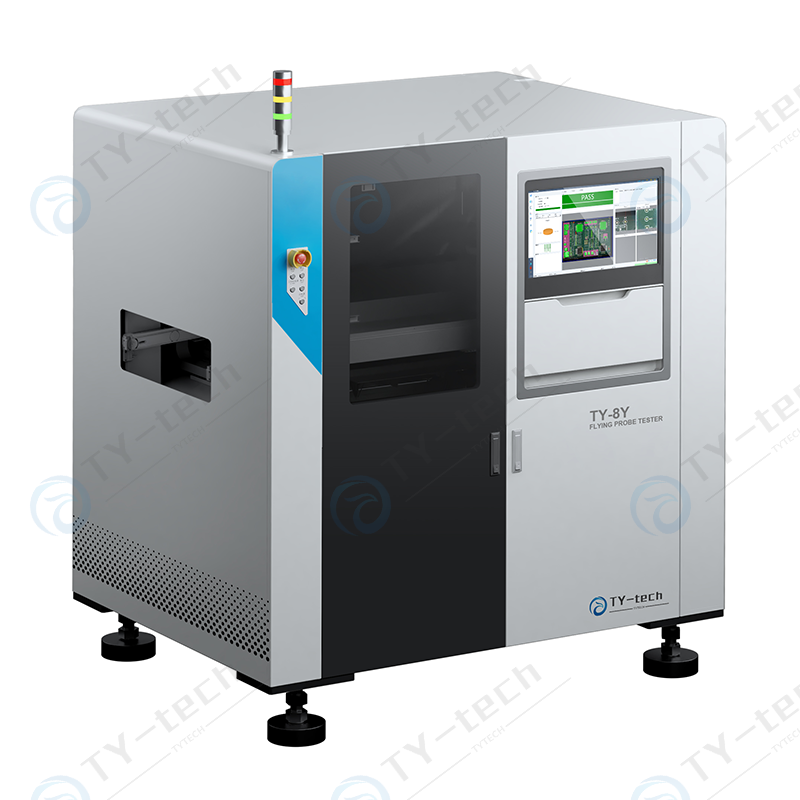Feature
Advantages of flying probe tester:
Fast test development; lower cost test methods; flexibility for fast changeover; and fast feedback to designers during the prototype phase.
6-pin or 8-pin bed testers Flying probe testers can use double-sided testing, just like bed-of-nails testing, saving board flipping time.
New flying probe testers are used for soft landing functions, and the spring force of the spring probe can be reduced to 10g (0.1N). Although the test time is slightly increased, the puncture mark is almost invisible.
Therefore, compared with traditional ICT, the time required for flying probe testing is more than compensated by reducing the total test time.
The benefits of using a flying probe test system outweigh the disadvantages. For example, such a system provides the assembly process to start production only a few hours after receiving the CAD file. Therefore, prototype boards can be tested hours after assembly, unlike ICT, where high-cost test development and fixtures can delay the process for days or even months. Flying probe test systems also reduce the visual inspection time of the "first article" of new products, which is important because the first board often determines the test characteristics of the remaining UUTs.
【Key Features】
①Eight probes on double side with best price
② High accuracy ( 01005 package supported )
③ Precision linear rail system with high re-positioning accuracy
④ Online / Inline transmission supported
⑤ Horizonal transmission
⑥ Static LCRD test supported
Detail Image

Specifications
| Model | TY-8Y | |
|
Main Spec
|
Minimum Chip
|
01005(0.4mm x 0.2mm)
|
|
Min Compenent Pin Spacing
|
0.2mm
|
|
|
Min Contact Pad
|
0.15mm
|
|
|
Probes
|
4 Heads(Top)+4 Heads(Bottom)
|
|
|
Probe elastic force
|
120g(Default)
|
|
|
Probe Rated Stroke
|
1.5mm
|
|
|
Testable point types
|
Test points, Pads, Device Dlectrodes
Connectors, Irregular Components
|
|
|
Testing speed
|
Max 25 Steps/Sec
|
|
|
Repeatability
|
±0.005mm
|
|
|
Belt high
|
900±20mm
|
|
|
Belt Wideth
|
50mm ~ 630mm
|
|
|
Track width adjustment
|
Auto
|
|
|
Inline Mode
Offline Mode
|
Left (Right) In , Right (Left) Out
Left In, Left Out
|
|
|
Optics
|
Camera
|
4 Colorful Cameras, 12M Pixels
|
|
Laser Displacement Sensor
|
4 Sets
|
|
|
Test Area
|
Max Test Area
|
640mm x 600mm
|
|
Min Test Area
|
60mm x 50mm
|
|
|
TOP Clearence
|
≤50mm
|
|
|
BOT Clearence
|
≤50mm
|
|
|
Board Edge
|
≥3mm
|
|
|
Thickness
|
0.6mm ~ 6mm
|
|
|
Max PCBA Weight
|
10kg
|
|
|
Motion
Parameters
|
Probe Return Height
|
Programmed
|
|
Probe Pressing Depth
|
Programmed
|
|
|
Probe Soft Landing
|
Programmed
|
|
|
Z Distance
|
-3mm ~ 53mm
|
|
|
XY / Z Acceration
|
Max 3G / Max 20G
|
|
|
XYZ Driver
|
Linear Motor
|
|
|
XYZ Measure
|
Linear scale
|
|
|
XY Lead Rail
|
P-Grade precision guide rail
|
|
|
Testing
Capability
|
Resistors
|
1mΩ ~ 1GΩ
|
|
Capacitors
|
0,5pF ~ 1F
|
|
|
Inductors
|
0.5uH ~ 1H
|
|
|
Diodes
|
Yes
|
|
|
Zener diode
|
40V
|
|
|
BJT
|
Yes
|
|
|
Relay
|
40V
|
|
|
FETs
|
Yes
|
|
|
DC Constant Current Source
|
10nA ~ 1A
|
|
|
DC Constant Voltage Source
|
0 ~ 40V
|
|
|
AC Constant Current Source
|
100 ~ 500mVrms(200hz ~ 1Mhz)
|
|
|
Panel Test
|
Yes
|
|
|
2D Barcode
|
Yes
|
|
|
PCBA Deformation Compensation
|
Yes
|
|
|
MES Connection
|
Yes
|
|
|
LED Testing
|
Option
|
|
|
Open Pin
|
Option
|
|
|
On board programing
|
Option
|
|
|
Vayo DFT (6 CAD)
|
Option
|
|











